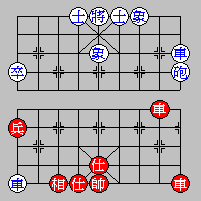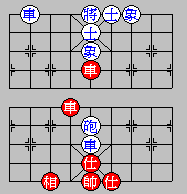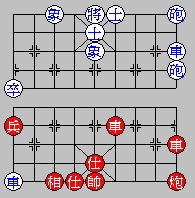35. Two or more pieces trying to capture a protected piece doesn't
constitute a "perpetual chase" and if neither side would change,
the game can be ruled as a draw. (See examples from Diagrams 86
to 89)

Diagram 86: Red (in Capital) moves first
R2+2 c9+2
R2-2 c9+1
R2-1 c9-1
R2+1 c9-2
R2+2 ....
.
.
 Diagram 87: Red (in Capital) moves first
Diagram 87: Red (in Capital) moves first
R7-1 c5-1
R7+1 c5+1
R7-1 c5-1
R7+1 c5+1
R7-1 ....
Explanation:
In Diagrams 86 and 87 the two Red Rooks' trying to capture the protected
Black Cannon does not violate the rule. It will be a draw if neither
side changes.
 Diagram 88: Red (in Capital) moves first
Diagram 88: Red (in Capital) moves first
R4+3 c9+1
R4-1 c9+1
R4-1 c9-2
R4+2 c9+1
R4-1 ....
Explanation:
The two Red Rooks' trying to capture the protected Black Cannon
does not violate the rule. It will be a draw if neither side
changes.
 Diagram 89: Red (in Capital) moves first
Diagram 89: Red (in Capital) moves first
C67 k3-1
R79 k1+3
R97 k3-1
R79 k1+3
R97 ....
Explanation:
The Red's Rook and two Cannons keep trying to capture the Black
Knight. This does not violate the rule and the game will be a
draw if neither side changes.




